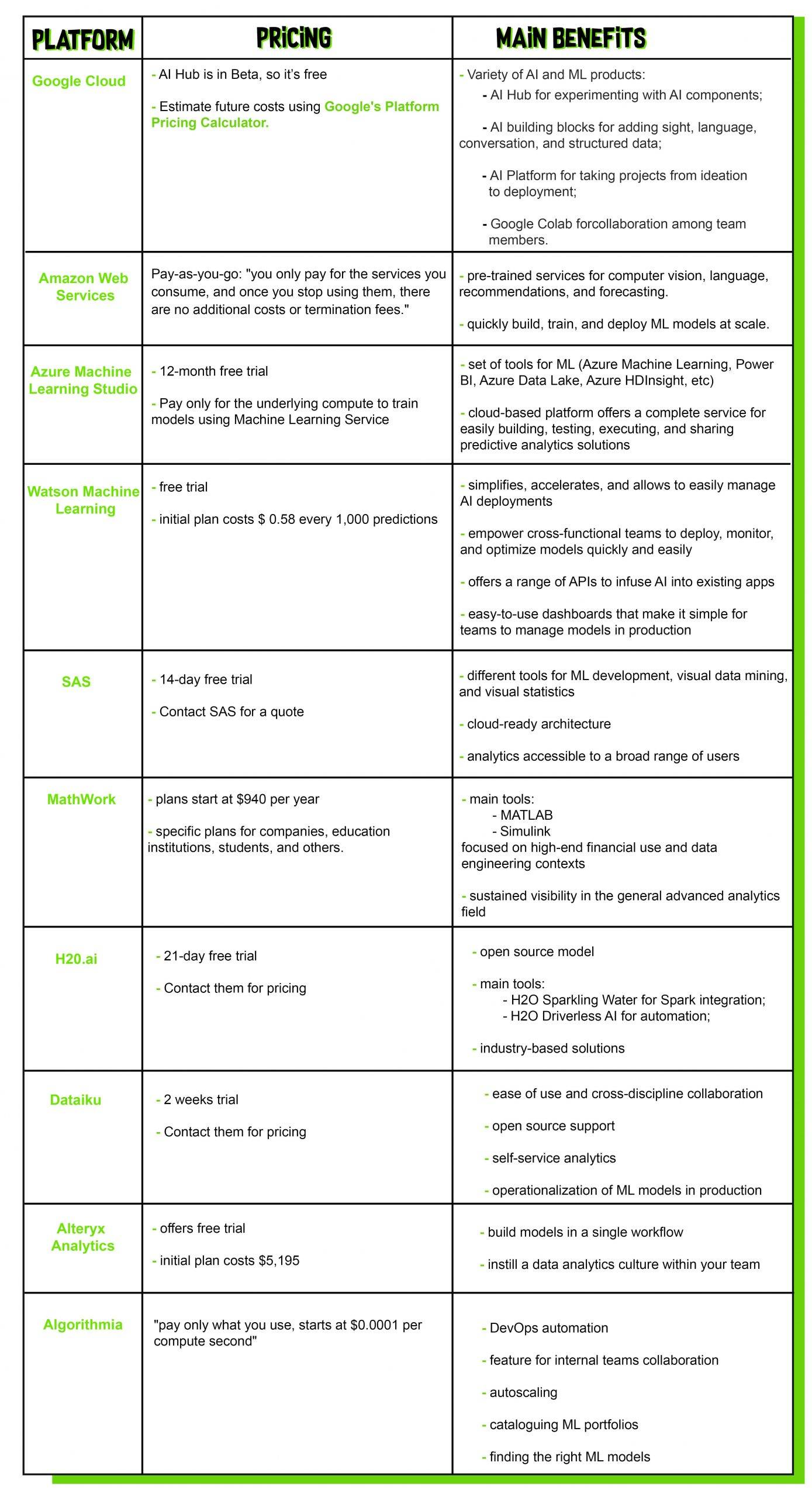Machine Learning basics: 10 Platforms to start learning
Machine Learning is everywhere. Literally! It’s in your home, the businesses you frequent, and the companies, factories, hospitals and gyms that fill the world and our time. It’s the directions we use to navigate, the recommendations we receive that inform our purchases, our job searches and news preferences. It’s the chatbots that provide helpful responses and the fraud detectors we rely on to keep our accounts safe. It’s cybersecurity, medical image analysis and self-driving cars. It is transforming our lives from listening to music to early cancer detection.
And whether you’re a novice or an expert, in the field of technology or finance, medicine or retail, machine learning is revolutionizing your industry and doing it at a rapid pace. You may recognize the ways that Machine Learning can improve your life and work but may not know how to implement it in your own company. That’s where we come in today with our Machine Learning basics.
Companies of all shapes and sizes and across various industries are launching intelligent systems and applications every day. If you are not one of them, then your teams, clients and investors are probably wondering when you’ll join in.
According to the Harvard Business Review, over the next five to 10 years, “business gains will likely stem from getting the right information to the right people at the right time”. This means companies will continue building upon Machine Learning solutions to turbocharge and automate methods finding customer patterns that identify customer values. There’s a forecasted demand for Machine Learning that spans various industries.If you haven’t already started, there’s no better time than the present and no better list that our Machine Learning basics selection.
But how do you get started? What are the possible uses of Smart Apps in your business and how do you determine which ML development and deployment platform is the best for you?
We get it, there are a lot of questions, and even more possibilities. Like the AI improving every day, you’re also interested in improving your company offerings, user experience, products or processes or all of the above.
For this post we will recommend a set of 10 Machine Learning basics: development and deployment platforms for your ML projects. We’ll provide insights and observations, based on our own experiences developing ML applications.
We also invite you to access our Business Executive’s Guide to Smart Applications, an in-depth e-book which includes important concepts and definitions concerning AI, ML, and recommended systems, as well as business cases and reviews, evaluating various tools so you are informed when selecting the right solution for your business needs. You can easily access our free eBook here:
Now, let’s dig a little deeper into development and deployment platforms, what’s out there and what differentiates one from another. Before we break them down, let’s review what a strong development platform might look and feel like, what it should include and provide. As reported by Gartner, a good ML development platform:
- Offers building blocks for creating a solution to a data science problem;
- Provides experts with an environment where they can incorporate the solutions into products and business processes;
- Grants support for carrying out data and analytics tasks;
- Allows data scientists and developers to take on tasks that encompass visualization, interactive exploration, deployment, performance engineering, data preparation, and data access.
So now we know what we’re looking for. Keep these standards in mind when considering the following 10 platforms that are our Machine Learning basics, and the tools we think are the most interesting for developing and deploying smart apps:
Innovative ML products and services on a well-known and widely trusted platform.
Google offers several AI and Machine Learning products: AI Hub, a repository of plug and play AI components which encourages experimentation and collaboration; AI building blocks for adding sight, language, conversation, and structured data to their apps; AI Platform, a code-based science development environment that lets ML developers and data scientists take projects from ideation to deployment quickly; among other AI resources.
Another great feature is the ability to collaborate as a team with GoogleColab for the research phase of any project. This tool allows devs to work on an established web environment, so they can collaboratively share experiments.
Pricing: as the AI Hub is in its Beta version, there is currently no cost. For an estimation of what other products would cost, use Google’s Platform Pricing Calculator.
Build powerful AI on the most advanced machine learning platform. AWS has removed all ML barriers that have traditionally slowed down devs and data scientists. Amazon offers the broadest and deepest set of ML and AI services, including pre-trained services for computer vision, language, recommendations, and forecasting. Its Amazon SageMaker tool is a compelling option for quickly building, training and deploying machine learning models at scale.
Pricing: AWS offers a pay-as-you-go model so you only pay for the services you consume and once you stop using them, there are no additional costs or termination fees.
Microsoft’s Azure Machine Learning Studio
Machine Learning Studio is a powerfully simple browser-based, visual drag-and-drop authoring environment where no coding is necessary. Go from idea to deployment in a matter of clicks.
Microsoft’s set of tools for ML includes Azure Machine Learning (including Azure Machine Learning Studio), Power BI, Azure Data Lake, Azure HDInsight, Azure Stream Analytics and Azure Data Factory. Its cloud-based platform offers a complete service, ideal for data scientists who want to build, test, execute, and share predictive analytic solutions easily.
Pricing: try it out free for 12-months. Users only pay for underlying compute to train models using Machine Learning Service.
IBM Watson Machine Learning helps data scientists and developers work together to accelerate the process of moving to deployment and integrating AI into their applications.
This IBM platform and integrations empower cross-functional teams to deploy, monitor and optimize models quickly and easily. They also offer a range of APIs to infuse AI into existing apps. All options are managed through dashboards. They make it simple for teams to manage models in production and through seamless workflows that enable continuous retraining to maintain and improve model accuracy.
Pricing: free trial and plans start at $ 0.58 every 1,000 predictions.
Whether you’re a data scientist, business analyst, statistician or forecaster, you’ll discover the real power of SAS® to explore, analyze and visualize data.
Different tools such as SAS Visual Analytics and SAS Visual Data Miner & Machine Learning, offers a great option for machine learning development, visual data mining and visual statistics. We want to highlight SAS’s cloud-ready architecture, making analytics more accessible to a broader range of users.
Pricing: a free trial lasts 14 days. To receive a quote, contact SAS.
Explore the wide range of product capabilities and find the right solution for your application or industry.
To design AI models and AI-driven systems, MathWork’s tools MATLAB and Simulink are the company’s most recognized products. MathWork focused on the development of these tools to become experts in high-end financial use and data engineering contexts. Nowadays, MathWorks provides users with a sustained visibility in the general advanced analytics field. Also, its solid presence in data science and machine learning software marketplace has built a strong user base.
Pricing: for an individual license the plan starts at $940 a year. There are also specific plans for companies, educational institutions, students, and others.
H2O.ai is the creator of the leading open-source machine learning and artificial intelligence platform trusted by hundreds of thousands of data scientists driving value in over 18,000 enterprises globally.
Following its vision of democratizing intelligence for all, H20.ai relies on an open source model organized in tools such as H2O Sparkling Water for those interested in Spark integration; H2O Driverless AI for automation; industry-based solutions; and more. This company has jumped positions on Gartner’s list thanks to its innovative approach and thoughtful leadership in the form of content and documentation.
Pricing: free 21 day trial. For more information, contact H20.ai.
Bring data analysts, engineers, and scientists together. Enable self-service analytics and operationalize machine learning.
This NYC company offers a Data Science Studio with a focus on cross-discipline collaboration and ease of use, enabling users to start Machine Learning projects rapidly. Also, a big part of their product roadmap is based on collaboration and open source support. Their goal is to power both self-service analytics and the operationalization of ML models in production.
Pricing: free 2-week trial. For more information, contact Dataiku.
Leading in the self-service data analytics movement with a platform that can discover, prepare, and analyze your data, then deploy and share analytics at scale for deeper insights faster than you ever thought possible.
Alteryx is one of the leaders at Gartner’s Magic Quadrant. Among its advantages, the platform allows you to build models in a single workflow. More than a platform, Alteryx Analytics’s product vision aims to help organizations instill a data analytics culture through events, documentation, and a thriving community.
Pricing: a free trial with plans starting at $5,195 a year.
Operationalize your Machine Learning life cycle. The AI Layer abstracts your models from infrastructure, so you can focus more on what matters as you scale.
This company provides AI Layer, a flexible and robust platform for managing and deploying ML models at scale. It includes accessible tools to automate DevOps for ML, collaborate across various internal teams, and optimize hardware usage. It also aims to solve common problems in the ML workflow by autoscaling, cataloguing ML portfolios, and finding the right ML models.
Pricing: According to Algorithmia, pay only what you use, starting at $0.0001 per compute second.

There are top ten lists for all kinds of products and experiences, and that’s our Machine Learning basics for development and deployment platforms for machine learning projects. Feel free to suggest others so we can continue to fine tune our list and inform our recommendations. Also share this article with fellow CTOs or other tech leaders and innovators on the quest to find the right platform for creating a successful ML project. Let’s keep improving our company offerings, user experiences and daily lives through Machine Learning. There’s no time like the present.
And if you want to go beyond Machine Learning basics and you didn’t already, sign up for our free e-book to learn more:



1 comment